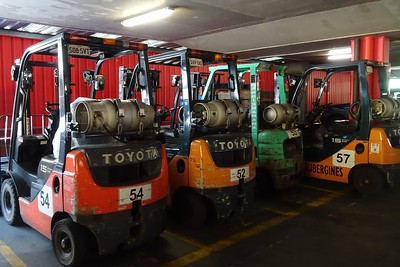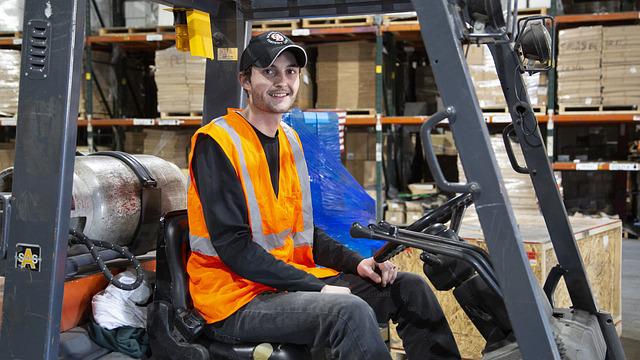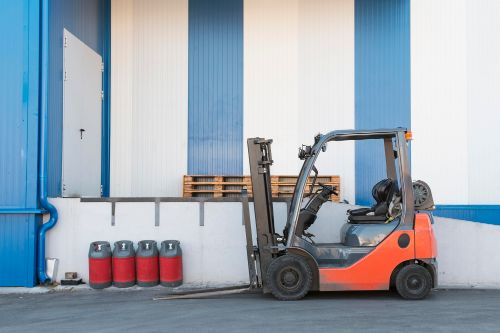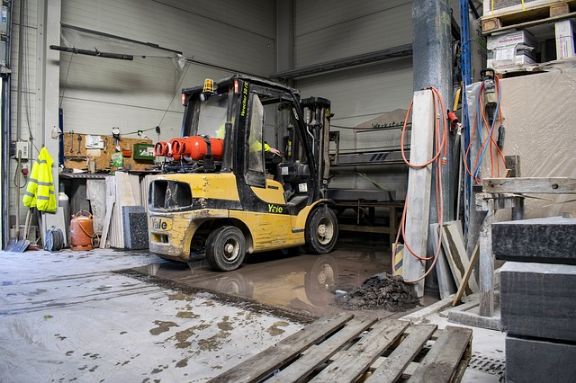
A 10 gallon forklift propane tank is a large, cylindrical tank that is used to store and transport propane. It is typically made of steel or aluminum and has a capacity of 10 gallons. The tank is usually mounted on the back of a forklift and is connected to the forklift’s engine via a hose. The tank is typically filled with propane at a propane station.
The 10 gallon forklift propane tank is a safe way to store and transport propane. The tank is made of steel or aluminum and is designed to withstand high pressures. The tank is also equipped with a pressure relief valve to prevent the tank from rupturing.
This capacity tank is a versatile way to store and transport propane. It can be used to power a forklift, grill, or other propane-powered appliances. The tank can also be used to fuel a backup generator.
This capacity tank is a great way to have a backup supply of propane for your forklift. It is also a good idea to have one on hand in case of an emergency.
Popular brands are: Worthington, Manchester, Flame King. These tanks have the following specifications:
- Collar: 10-1/4 inches
- Height: 29.3 inches
- Diameter: 12.3 inches
- Weight (Filled): 43.2 lbs.
- Footring: 8 inches
- WC: 104.00 lbs.
- Tare Weight: 26.5 lbs.
- Construction: Steel/Aluminum
- Availability: Widely available in the market
Again, these specifications are for standard steel tanks. The specifications may differ depending on the brand and material. But, the most important specs are the body diameter and height to ensure that it fits at the back of the forklift and its holding latch.
Read related article: Forklift Propane Tank Exchange (Cost 2023, Where to Fill These Cylinders)
Capacity and Size
Detailed Description of a 10-Gallon Propane Tank’s Capacity
- Capacity Explained: A 10-gallon propane tank holds approximately 40 pounds of propane. This capacity is a common choice for forklifts due to its balance between size and operational duration.
- Fuel Efficiency: On average, a forklift can operate for around 8 hours on a single 10-gallon tank, depending on the forklift’s size and workload.
- Refill Frequency: The capacity allows for sufficient operating time while minimizing the frequency of refills, which is critical for maintaining productivity in industrial or warehouse settings.
Dimensions and Physical Size Considerations
- Standard Dimensions: Typically, a 10-gallon propane tank measures around 12 inches in diameter and 30 inches in height. However, these dimensions can vary slightly based on the manufacturer.
- Weight When Full: A full 10-gallon propane tank weighs about 170 pounds, which includes the weight of the propane and the tank itself.
- Space Requirements: When choosing a tank, it’s important to consider the space available on the forklift for mounting the tank. The tank should fit securely and not obstruct the operator’s view or movement.
Suitability for Different Types of Forklifts
- Compatibility with Forklift Models: These tanks are compatible with most standard forklift models designed for propane use. However, it’s essential to check the specific requirements of the forklift, including the mounting hardware and fuel line connections.
- Indoor vs. Outdoor Use: The 10-gallon capacity is suitable for both indoor and outdoor use. For indoor use, particularly in confined spaces, the emissions and safety standards of propane tanks must be carefully considered.
- Consideration for Workload and Usage Frequency: For operations with high fuel consumption or long shifts, a 10-gallon tank offers a good balance between weight and fuel capacity. It reduces the need for frequent tank changes compared to smaller tanks.
A 10-gallon propane tank is a versatile and efficient choice for many forklift operations, offering a balance between size, weight, and fuel capacity. It’s important to ensure that the tank’s dimensions fit the forklift and to consider the specific needs of the operation, including the type of forklift, workload, and operating environment.
Read related article: Forklift Propane Tank Orientation: Do These for Universal Tank
Steel vs Aluminum Tanks
| Feature | Steel Tanks | Aluminum Tanks |
|---|---|---|
| Weight | Heavier, adding to overall weight | Lighter, reducing overall weight |
| Durability | More robust and resistant to punctures | Less robust, but generally durable |
| Corrosion | Prone to rust without proper treatment | Naturally resistant to corrosion |
| Cost | Generally less expensive | More expensive due to material costs |
| Maintenance | Requires regular inspection for rust | Lower maintenance, especially in humid climates |
| Lifespan | Long lifespan with proper maintenance | Long lifespan, often longer due to corrosion resistance |
| Heat Conductivity | Poor conductor of heat, slower temperature changes | Better conductor, faster response to temperature changes |
| Use in Industries | Common in industries where weight is not a critical factor | Preferred in industries where weight reduction is beneficial |
| Recyclability | Highly recyclable, but may rust over time | Highly recyclable and retains properties after recycling |
| Appearance | Might require painting or coating | Aesthetic natural metallic appearance |
Safety Specifications for Forklift Propane Tanks
Material and Construction Standards
- Steel Construction: Many forklift propane tanks are made of steel, known for its durability and strength. When selecting a tank, ensure it’s constructed with high-quality steel to withstand the rigors of industrial environments.
- Aluminum Tanks: Some tanks are made from aluminum, offering a lightweight alternative to steel. Aluminum is less prone to corrosion, which can be a significant advantage in certain environments.
- Thickness and Durability: Check the thickness of the tank walls. Thicker walls typically mean better durability and resistance to damage.
- Welding Quality: The welding on the tank should be of high quality, as poor welding can lead to leaks or structural weaknesses.
Pressure Ratings and Safety Valves
- Pressure Rating: Ensure the tank’s pressure rating meets or exceeds the requirements for your specific application. The rating indicates the maximum pressure the tank can safely hold.
- Safety Valves: A critical component for safety, these valves prevent over-pressurization of the tank. Look for tanks with reliable safety relief valves that are easily accessible for inspection and maintenance.
- OPD (Overfill Prevention Device): Tanks should have an OPD valve, which stops the filling process once the tank reaches its safe fill level, preventing overfilling.
Compliance with Industry Standards and Regulations
- DOT and ASME Standards: In the United States, tanks should comply with the Department of Transportation (DOT) and the American Society of Mechanical Engineers (ASME) standards. These certifications ensure the tank has been tested and meets specific safety requirements.
- Local and International Regulations: Depending on your location, there may be additional local or international regulations that the tanks need to comply with. It’s crucial to be aware of these to ensure legal compliance.
- Regular Inspections and Certifications: Tanks should be regularly inspected and recertified as per the regulatory guidelines. This ensures they remain safe for use over time.
- Manufacturer’s Guidelines: Follow the manufacturer’s guidelines for installation, use, and maintenance. They often provide specific instructions to ensure the safe operation of their tanks.
By paying close attention to these safety specifications, you can ensure that the forklift propane tank you choose not only enhances the efficiency of your operations but also maintains the highest safety standards, protecting both your workforce and equipment.
Read related article: Forklift Propane Tank Exchange (Find a Company/Supplier)
Cost Considerations
Average Price Range for a 10-Gallon Forklift Propane Tank
- Price Range: The cost of a 10-gallon forklift propane tank typically ranges from approximately $150 to $300. This price can vary based on several factors, including the brand, material quality, and additional features.
- Rental vs. Purchase: Some companies offer the option to rent these tanks, which can be a cost-effective solution for short-term needs. Rental prices will vary based on the rental duration and the supplier’s policies.
Factors Affecting the Cost
- Materials Used: Tanks made with higher-grade steel or materials that offer better durability and safety features tend to be more expensive. The quality of the material can impact the tank’s lifespan and reliability.
- Brand Reputation: Well-known brands often charge more due to their reputation for quality and reliability. However, lesser-known brands might offer similar quality at a lower price.
- Certifications and Compliance: Tanks that meet specific safety standards or have certifications (like DOT or ASME) can be more costly. These certifications ensure the tank meets industry safety standards, which is crucial for hazardous materials like propane.
- Additional Features: Features such as built-in gauges, advanced safety valves, or specialized coatings that offer extra protection against corrosion can add to the cost.
- Supplier Factors: The cost can also be influenced by the supplier’s location, warranty offerings, and after-sales support services.
Tips for Finding Cost-Effective Options Without Compromising Quality
- Comparative Shopping: Research and compare prices from multiple suppliers to find the best deal. Online platforms can be useful for comparing prices and reading customer reviews.
- Consider Refurbished Tanks: Purchasing refurbished or gently used tanks can be a cost-effective option. Ensure they are certified and inspected for safety.
- Bulk Purchases: If buying multiple tanks, look for bulk purchase discounts. Suppliers often offer reduced prices for larger orders.
- Negotiate with Suppliers: Don’t hesitate to negotiate the price, especially when establishing a long-term relationship with a supplier.
- Look for Warranty and After-Sales Services: A good warranty and after-sales service can save costs in the long run, even if the initial purchase price is higher.
- Check for Trade-In Options: Some suppliers offer trade-in deals where you can exchange an old tank for a discount on a new one.
- Consider Total Cost of Ownership: Factor in the maintenance, refilling costs, and lifespan of the tank. A cheaper tank that requires more frequent replacement or maintenance may end up being more expensive over time.
While the initial cost is an important consideration, it’s crucial to evaluate the total cost of ownership, including maintenance, safety, and lifespan of the tank. Balancing cost with quality and safety standards is key when selecting a forklift propane tank.
Read related article: What Size Propane Tank Does a Forklift Take?
Connection and Compatibility for Forklift Propane Tanks
Types of Valves and Connectors
- Service Valves: These are the primary valves through which propane is filled and withdrawn. They should be easy to operate and compatible with standard filling equipment.
- Pressure Relief Valves: Essential for safety, these valves release propane if the pressure inside the tank gets too high, preventing potential hazards.
- Liquid and Vapor Service Ports: Depending on the forklift model, you may need tanks with liquid or vapor service ports. Ensure the tank has the correct type of port for your forklift’s fuel system.
- Couplings and Connectors: The connectors should be robust and provide a tight seal. Common types include POL (Prest-O-Lite), ACME, and quick-connect couplings, each having its unique characteristics.
- OPD (Overfill Prevention Device) Valves: These valves prevent the tank from being overfilled, a crucial safety feature. Ensure the tank has a compatible OPD valve.
Compatibility with Different Forklift Models
- Fuel System Type: Verify whether your forklift uses a vapor or liquid withdrawal system and choose a tank that is designed for that system.
- Mounting Requirements: Forklifts have specific mounting brackets for propane tanks. The tank you choose should fit these brackets without modification.
- Size and Weight Considerations: The physical size and weight of the tank should be compatible with the forklift’s design. An improperly sized tank can affect the forklift’s balance and maneuverability.
- Brand-Specific Requirements: Some forklift brands may have specific requirements or proprietary connections. Check with the forklift manufacturer for any brand-specific compatibility issues.
Ensuring Proper Fit and Secure Connection
- Check Tank and Forklift Specifications: Before purchasing, compare the tank’s specifications with the forklift’s requirements to ensure compatibility.
- Professional Installation: If you’re unsure about the connection process, consider professional installation. This ensures that the tank is properly and safely installed.
- Regular Inspection of Connections: Regularly inspect hoses, connectors, and valves for wear and tear. Replace them if you notice any damage or deterioration.
- Training for Operators: Ensure that operators are trained in how to correctly connect and disconnect the tanks. Improper handling can lead to leaks and safety risks.
- Use of Proper Tools: Using the right tools for connecting and disconnecting the tank can prevent damage to the valves and connectors.
- Follow Manufacturer’s Guidelines: Adhere to the tank manufacturer’s instructions for connection and maintenance. This ensures both safety and compliance with warranty requirements.
By carefully considering these aspects of connection and compatibility, you can ensure a safe and efficient operation, minimizing risks and maximizing the performance of your forklifts.
Here are Some Tip When Buying
When you’re looking to purchase a forklift propane tank, especially a 10-gallon one, there are several key factors you should consider to ensure you make the best choice for your needs. Here are some tips to guide you through the process:
- Understand Your Requirements: First, assess the specific needs of your forklifts. Consider the size, fuel consumption, and the nature of your operations (indoor, outdoor, intensity of use). This understanding will help you choose a tank that meets your requirements without overspending on unnecessary features.
- Check Tank Specifications: Pay close attention to the capacity, dimensions, and weight of the tanks. You want to ensure that the tank fits your forklift and that your forklift can handle the weight of a full tank.
- Prioritize Safety and Compliance: Safety should be your top priority. Look for tanks that adhere to industry standards and certifications. This not only ensures safety but can also save you from legal and compliance issues in the future.
- Consider Material and Durability: Decide between steel and aluminum tanks based on your needs. Steel tanks are more durable and less expensive, but heavier. Aluminum tanks are lighter and corrosion-resistant but might be pricier.
- Evaluate Cost Efficiency: While the initial cost is important, consider the long-term expenses such as maintenance, refills, and potential repairs. Sometimes, a slightly more expensive tank can be more cost-effective in the long run.
- Research Suppliers: Don’t rush into a purchase without researching suppliers. Look for reputable suppliers with good reviews, and don’t hesitate to ask them questions about their tanks, services, and after-sales support.
- Explore Warranty and Service Options: A good warranty and accessible customer service can be lifesavers. Check what kind of support is available in case of issues with the tank.
- Ask About Delivery and Installation Services: Some suppliers offer delivery and installation services. If you’re new to using propane tanks, professional installation can ensure safety and proper setup.
- Consider Environmental Impact: If sustainability is a concern for you, research the environmental impact of the tank. This includes its lifespan, recyclability, and the ecological footprint of its production and disposal.
- Plan for Future Needs: Think about your long-term needs. If your business is expanding, you might need a larger tank or more tanks in the future. Consider a supplier who can cater to your growing needs.
By keeping these tips in mind, you can make a well-informed decision when buying a forklift propane tank, ensuring safety, efficiency, and cost-effectiveness for your operations.
Propane Tank Installation on the Forklift
A 10 gallon forklift propane tank installation typically involves mounting the tank on the forklift, connecting the hoses and fittings, and then performing a safety check. The entire process usually takes around 5 minutes.
It is important to follow all safety instructions when performing a propane tank installation. Always wear gloves and safety glasses when working with propane. Make sure the tank is properly secured before beginning any work.
Connect the fill valve to the tank using a hose and fitting. Connect the regulator to the tank using another hose and fitting. Be sure to use the correct size wrench to tighten all connections.
Once the hoses and fittings are in place, open the valve on the tank and check for leaks. Use a soapy water solution to check all connections for leaks. If any are found, tighten the connection or replace the damaged hose or fitting.
After the tank has been checked for leaks, close the valve and bleed the regulator. This will remove any air from the system and prevent the regulator from freezing.
Once the regulator has been bled, open the valve on the tank and slowly turn on the gas. Adjust the regulator until the desired pressure is reached. Close the valve and recheck all connections for leaks.
Finally, perform a safety check of the entire system. Make sure there are no leaks and that all connections are secure. Test the forklift to make sure it is operating properly.
Be sure that the latch can hold the diameter of the tank. If you have standard size latch, it would not be able to hold the 10-gal tank. The 10-Gal tank has a body diameter of 12.3 inches. Make sure the latch can hold this. In addition, make sure if the tank is positioned vertically or horizontally.
Choosing the Right Supplier for Forklift Propane Tanks
Factors to Consider When Choosing a Supplier
- Reputation and Reliability: Research the supplier’s track record in the market. Look for reviews or testimonials from other businesses to gauge their reliability and the quality of their products.
- Quality of Products: Ensure the supplier offers tanks that meet or exceed industry standards. High-quality materials, construction, and safety features should be non-negotiable.
- Range of Products: A good supplier should offer a variety of tank sizes and types to cater to different needs. Check if they have the specific type of tank you require.
- Compliance with Standards: Confirm that their products comply with relevant safety and quality standards, such as DOT and ASME certifications for propane tanks.
- Pricing and Cost-Effectiveness: Compare prices with other suppliers, but remember that the cheapest option isn’t always the best. Factor in the quality and lifespan of the tanks.
- Availability and Lead Times: Consider the supplier’s ability to fulfill orders promptly. Long lead times can impact your business operations.
- Location and Shipping: A supplier closer to your location can reduce shipping costs and delivery times. However, don’t compromise on quality for the sake of convenience.
The Importance of After-Sales Support and Service
- Customer Service: Good customer service is crucial. The supplier should be easily reachable and responsive to your queries and concerns.
- Technical Support: Especially if you’re new to using propane tanks, having access to knowledgeable technical support is valuable. They can assist with installation, troubleshooting, and maintenance advice.
- Warranty and Guarantees: Understand the warranty provided with the tanks. A robust warranty indicates the supplier’s confidence in their product’s quality.
- Maintenance and Repair Services: Inquire if the supplier offers maintenance and repair services. This can be a significant advantage for ensuring the longevity and safety of your tanks.
- Training and Resources: Some suppliers offer training sessions or resources for safely handling and maintaining the tanks. This added service can be beneficial, especially for your staff’s safety training.
- Long-Term Relationship: Consider the potential for a long-term relationship. A supplier who values long-term client relationships may offer better service, support, and pricing.
By carefully evaluating these factors, you can choose a supplier that not only meets your immediate needs for a forklift propane tank but also supports your operations in the long run with quality products and exceptional service.
To Make a Conclusion
Selecting the right 10-gallon propane tank for your forklift is a decision that requires careful consideration of various factors to ensure safety, efficiency, and cost-effectiveness. Understanding the specific needs of your operation, such as the type of forklift, work environment, and usage patterns, is crucial in making an informed choice.
Key specifications like the tank’s material, size, weight, and safety features, including pressure ratings and compliance with industry standards, play a vital role in ensuring operational efficiency and the safety of your workforce. The importance of choosing a reliable supplier cannot be overstated; one who not only provides high-quality tanks but also offers excellent after-sales support and services.
Balancing cost considerations with quality and safety standards is essential. While initial costs are important, factors such as maintenance, durability, and total cost of ownership should be evaluated to make a cost-effective decision. Ensuring proper connection and compatibility with your forklift models will enhance performance and reduce the risk of accidents.
In essence, a well-chosen 10-gallon forklift propane tank is an investment in your business’s productivity and safety. By considering these key specs and factors, you can ensure that you select a tank that meets your operational needs while adhering to the highest standards of safety and efficiency.

Mike is an experienced propane technician with over 15 years of professional experience in the field. He has dedicated his career to helping customers with their propane needs, from installation to maintenance and repair. Together with Jeremy, he co-founded this website to provide useful information and guidance to customers seeking reliable propane services.



